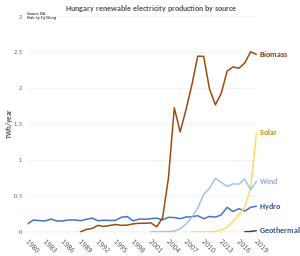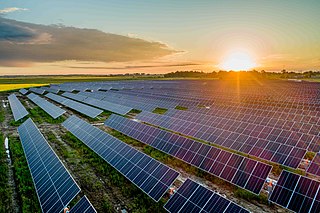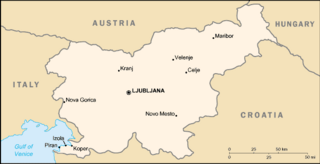
Energy in Hungary describes energy and electricity production, consumption and import in Hungary. Energy policy of Hungary describes the politics of Hungary related to energy.

Energy in Hungary describes energy and electricity production, consumption and import in Hungary. Energy policy of Hungary describes the politics of Hungary related to energy.
|
|
|
CO2 emissions: |
Hungary had, in 2017, four operating nuclear power reactors, constructed between 1982 and 1987, at the Paks Nuclear Power Plant. [2]
An agreement in 2014 with the EU and an agreement between Hungary and Rosatom may result in an additional two reactors being built for operation in 2030. The cost, estimated at €12.5bn, being funded mainly by Russia. [3]
Hungary is reliant on oil from Russia for 46% of its needs in 2021, a decrease from 80% in 2013. [4]
An EU exemption to sanctions, following the Russian invasion of Ukraine in 2022 allows Hungary to continue importing oil from Russia until December 2023. [5]
MOL Group is an oil and gas group in Hungary.
Emfesz is a natural gas distributor in Hungary. Panrusgáz imports natural gas from Russia mainly Gazprom.
The Arad–Szeged pipeline is a natural gas pipeline from Arad (Romania) to Szeged (Hungary).
Nabucco and South Stream gas pipelines were intended to reach Hungary and further to other European countries. The Nabucco gas pipeline was expected to pipe 31bn cubic metres of gas annually in a 3,300 km long pipeline constructed via Hungary, Turkey, Romania, Bulgaria and Austria. The South Stream gas pipeline was expected to pipe 63bn cu m of gas from southern Russia to Bulgaria under the Black Sea. The pipe was planned to run via Hungary to central and southern Europe. [6] These two were abandoned early in their design phases by a mix of disinterest, changing priorities and changes in geopolitical conditions in the larger Black Sea basin.
Hungary in 2022 is reliant on Russia for 80% of its natural gas and seeks to continue buying from Gazprom. [7] In October 2023 Bulgaria passed a law taxing Russian gas in transit to Hungary at 20 levs (10.22 euro) per MWh, roughly 20% of the purchase price of gas, the cost is probably payable by Gazprom. Hungary has complained about the tax. [8]
The last coal electricity producer, the Matra Power Plant produced around 9% of the electricity needs of Hungary in 2020. It is served by two coal mines in Visonta, and in Bükkábrány. The current generator is to shut down in 2025 to be replaced by a CCGT unit.

Hungary is a member of the European Union and thus takes part in the EU strategy to increase its share of the renewable energy. The EU has adopted the 2009 Renewable Energy Directive, which included a 20% renewable energy target by 2020 for the EU. [9] By 2030 wind should produce in average 26-35% of the EU's electricity and save Europe €56 billion a year in avoided fuel costs. [10]
The national authors of Hungary forecast is 14.7% renewables in gross energy consumption by 2020, exceeding their 13% binding target by 1.7 percentage points. Hungary is the EU country with the smallest forecast penetration of renewables of the electricity demand in 2020, namely only 11% (including biomass 6% and wind power 3%). The forecast includes 400 MW of new wind power capacity between 2010 and 2020. EWEA's 2009 forecast expects Hungary to reach 1.2 GW of installed wind capacity in this time. [9] In the end of 2010 wind power capacity was 295 MW. [11]
No new wind farms have been built since 2012, with a law in 2016 effectively banning wind farms in Hungary by requiring they be built further than 12km from any community. Capacity in 2022 is 330MW. In 2022 Hungary published a Recovery and Resilience Plan outlining a total of HUF 2,300 billion (ca. EUR 6 billion) for strategic development projects with the energy sector, [12] which may result in additional wind farms being built.
Hungary had 4.8GW capacity for solar power in 2022, having grown from 26MW in 2016. The 2030 National Energy Strategy target is for 6GW capacity. [13]
In 2007, emissions of carbon dioxide totalled 53.9 million tonnes or around 5.4 tonnes per capita when the EU-27 average was 7.9 tonnes per capita. [14]

Energy in Bulgaria is among the most important sectors of the national economy and encompasses energy and electricity production, consumption and transportation in Bulgaria. The national energy policy is implemented by the National Assembly and the Government of Bulgaria, conducted by the Ministry of Energy and regulated by the Energy and Water Regulatory Commission. The state-owned company Bulgarian Energy Holding owns subsidiaries operating in different energy sectors, including electricity: Kozloduy Nuclear Power Plant, Maritsa Iztok 2 Thermal Power Plant, NEK EAD and Elektroenergien sistemen operator (ESO); natural gas: Bulgargaz and Bulgartransgaz; coal mining: Maritsa Iztok Mines. The state holds a 100% stake in the holding company. In Bulgaria, energy prices for households are state-controlled, while commercial electricity prices are determined by the market.

Energy consumption across Russia in 2020 was 7,863 TWh. Russia is a leading global exporter of oil and natural gas and is the fourth highest greenhouse emitter in the world. As of September 2019, Russia adopted the Paris Agreement In 2020, CO2 emissions per capita were 11.2 tCO2.

Energy in Romania describes energy and electricity production, consumption and import in Romania.

Germany predominantly sources its energy from fossil fuels, followed by wind, nuclear, solar, biomass and hydro.

Energy in Finland describes energy and electricity production, consumption and import in Finland. Energy policy of Finland describes the politics of Finland related to energy. Electricity sector in Finland is the main article of electricity in Finland.

Energy in Armenia is mostly from natural gas. Armenia has no proven reserves of oil or natural gas and currently imports most of its gas from Russia. The Iran-Armenia Natural Gas Pipeline has the capacity to equal imports from Russia.

Energy in Belgium describes energy and electricity production, consumption and import in Belgium.

Russia supplies a significant volume of fossil fuels to other European countries. In 2021, it was the largest exporter of oil and natural gas to the European Union, (90%) and 40% of gas consumed in the EU came from Russia.

Energy in Austria describes energy and electricity production, consumption and import in Austria. Austria is very reliant on hydro as an energy source, supported by imported pil and natural gas supplies. It is planned by 2030 to become 100% supplied by renewable sources, primarily hydro, wind and solar.

Energy in Moldova describes energy and electricity production, consumption and import in Moldova.
The Polish energy sector is the sixth largest in Europe. The scale of energy consumption in 1996–2015 increased from 139,593 GWh to 161,438 GWh. According to the data of Polskie Sieci Elektroenergetyczne (PSE), electricity production in October 2020 amounted to 13,553 GWh; domestic consumption amounted to 14,798 GWh.

Primary energy consumption in Spain in 2015 was mainly composed of fossil fuels. The largest sources are petroleum (42.3%), natural gas (19.8%) and coal (11.6%). The remaining 26.3% is accounted for by nuclear energy (12%) and different renewable energy sources (14.3%). Domestic production of primary energy includes nuclear (44,8%), solar, wind and geothermal (22,4%), biomass and waste (21,1%), hydropower (7,2%) and fossil (4,5%).

Energy in Greece is dominated by fossil gas and oil. Electricity generation is dominated by the one third state owned Public Power Corporation. In 2009 DEI supplied for 85.6% of all electric energy demand in Greece, while the number fell to 77.3% in 2010. Almost half (48%) of DEI's power output in 2010 was generated using lignite. 12% of Greece's electricity comes from hydroelectric power plants and another 20% from natural gas. Between 2009 and 2010, independent companies' energy production increased by 56%, from 2,709 Gigawatt hour in 2009 to 4,232 GWh in 2010.
Energy in Estonia has heavily depended on fossil fuels. Finland and Estonia are two of the last countries in the world still burning peat.

Lithuania is a net energy importer. In 2019 Lithuania used around 11.4 TWh of electricity after producing just 3.6 TWh.
Energy in Luxembourg describes energy and electricity production, consumption and import in Luxembourg. Energy policy of Luxembourg will describe the politics of Luxembourg related to energy in greater detail. Electricity sector in Luxembourg is the main article of electricity in Luxembourg.

Primary energy use in Slovakia was 194 TWh and 36 TWh per million inhabitants in 2009.

Total primary energy supply (TPES) in Slovenia was 6.80 Mtoe in 2019. In the same year, electricity production was 16.1 TWh, consumption was 14.9 TWh.

Hungary is a member of the European Union and thus takes part in the EU strategy to increase its share of renewable energy. The EU has adopted the 2009 Renewable Energy Directive, which included a 20% renewable energy target by 2020 for the EU. By 2030 wind should produce in average 26-35% of the EU's electricity and save Europe €56 billion a year in avoided fuel costs. The national authors of Hungary forecast is 14.7% renewables in gross energy consumption by 2020, exceeding their 13% binding target by 1.7 percentage points. Hungary is the EU country with the smallest forecast penetration of renewables of the electricity demand in 2020, namely only 11%.

Fossil gas supplies over a quarter of Turkey's energy. The country consumes 50 to 60 billion cubic metres of this natural gas each year, nearly all of which is imported. A large gas field in the Black Sea however started production in 2023.